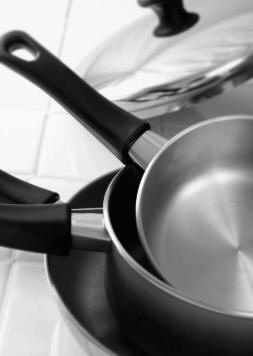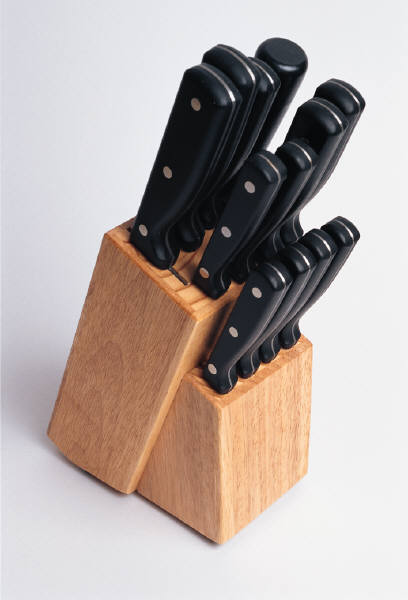|
Reclaiming The
Kitchen
|
|
|
The Proper Tools
 An
easy way to tell if someone cooks or not, is to take a peek inside of
their kitchens and see what kind of equipment you find. Contrary to what
the gadget sellers may tell you, it's not necessary to have a pile of
expensive crazy contraptions to make your kitchen experience more
enjoyable. In fact, the best tools are often the most simple ones. Here
are the four
essentials. An
easy way to tell if someone cooks or not, is to take a peek inside of
their kitchens and see what kind of equipment you find. Contrary to what
the gadget sellers may tell you, it's not necessary to have a pile of
expensive crazy contraptions to make your kitchen experience more
enjoyable. In fact, the best tools are often the most simple ones. Here
are the four
essentials.
Pans
A pan, by definition
is something used to cook on the stovetop. They come in all shapes and
sizes, with all sorts of different features, but they all have handles
and they are not designed to go in the oven. What makes a pan a pan, (as
opposed to a pot) is that it usually is wider than it is deep, and it is
used to prepare food by either frying, sautéing or simmering.
The most
important feature of a pan is that it have a thick, heavy bottom. The
reason is that when you cook food in a pan, your food is in direct contact
with the bottom of the pan. When your pan has a thick bottom the stove
heats the pan and the pan heats the food. When you try to cook in a pan
with a thin bottom, the heat from the burner goes straight through the
pan to the food. You end up with hot and cool spots across the bottom of
the pan. This means that the food doesn't cook evenly and is more apt to
burn.
Pots
A pot, as opposed to
a pan, generally is taller than it is wide, and it's generally used to
cook things with lots of liquid. Because of this, the thickness of the
bottom is generally less crucial. In fact, a thin bottomed pot can be an
asset if you're boiling lots of water for pasta or something, because
the water will heat faster if the heat from the burner is transferred
more quickly to the water rather than having to heat up the pot first.
Knives
 Knives come in all
shapes and sizes, but the main distinction is serrated and non-serrated.
Generally speaking non-serrated knives must be kept very sharp, and are
designed to be used with a straight downward cutting action. These types
of knives work well for cutting things that are fairly firm and
non-"squish-able" (in other words, don't try to cut bread or ripe
tomatoes with a non-serrated knife!) Serrated knives, on the other hand,
are designed to be used with a "sawing action". The serrated edge works
much like the teeth on a saw. Usually, the softer the item is that
you're trying to cut, the more deeply serrated you want the knife to be.
So bread knives and tomato knives generally have big scalloped
serrations, while all-purpose knives generally have smaller serrations. Knives come in all
shapes and sizes, but the main distinction is serrated and non-serrated.
Generally speaking non-serrated knives must be kept very sharp, and are
designed to be used with a straight downward cutting action. These types
of knives work well for cutting things that are fairly firm and
non-"squish-able" (in other words, don't try to cut bread or ripe
tomatoes with a non-serrated knife!) Serrated knives, on the other hand,
are designed to be used with a "sawing action". The serrated edge works
much like the teeth on a saw. Usually, the softer the item is that
you're trying to cut, the more deeply serrated you want the knife to be.
So bread knives and tomato knives generally have big scalloped
serrations, while all-purpose knives generally have smaller serrations.
Another distinction amongst knives is the width of the blade. Knives
with wide blades are useful for cutting straight (like chopping
vegetables) while think bladed knives are good for paring apples or
cutting anything where you need to make curves or have more control.
With all the choices and specialties out there, it's pretty easy to end
up with an entire kitchen full of knives. You're better
off with just a few... and they don't need to be expensive. One thing
that is important, however, is that they be comfortable in your hand.
Cutting Boards
If you want
to do any meaningful food preparation, a decent cutting board is a
necessity. You can find good cutting boards made out of either wood or
plastic. They also make glass cutting boards, but they tend to make a horrible "fingernails on
chalkboard" sound when the knife hits the board, and because the glass
has very little "give" the knife can slip if you hit the board at an
angle. Wooden boards give a great cutting surface, but they can be
difficult to clean since they can't go in the dishwasher. If you use a wooden board,
choose one made from a hardwood like oak or cherry, as opposed to
something soft like pine.
If you cut raw meat, fish, or anything
bacteria-laden, you need to clean the cutting board with soap, or even
bleach, and you need to scrub it with a brush to make sure you get into
all of the little crevices. Some people have separate cutting boards
used only for onions and garlic, since these things can leave odors and
even a taste that's hard to get out of the cutting board.
Another
important aspect of cutting boards is size. It may seem like a great big
cutting board is ideal because it gives you lots of room to work with,
but they can be a real pain to try to clean. Aim for something with
enough room to work, but still small enough to fit in the sink or
diswasher. |
|